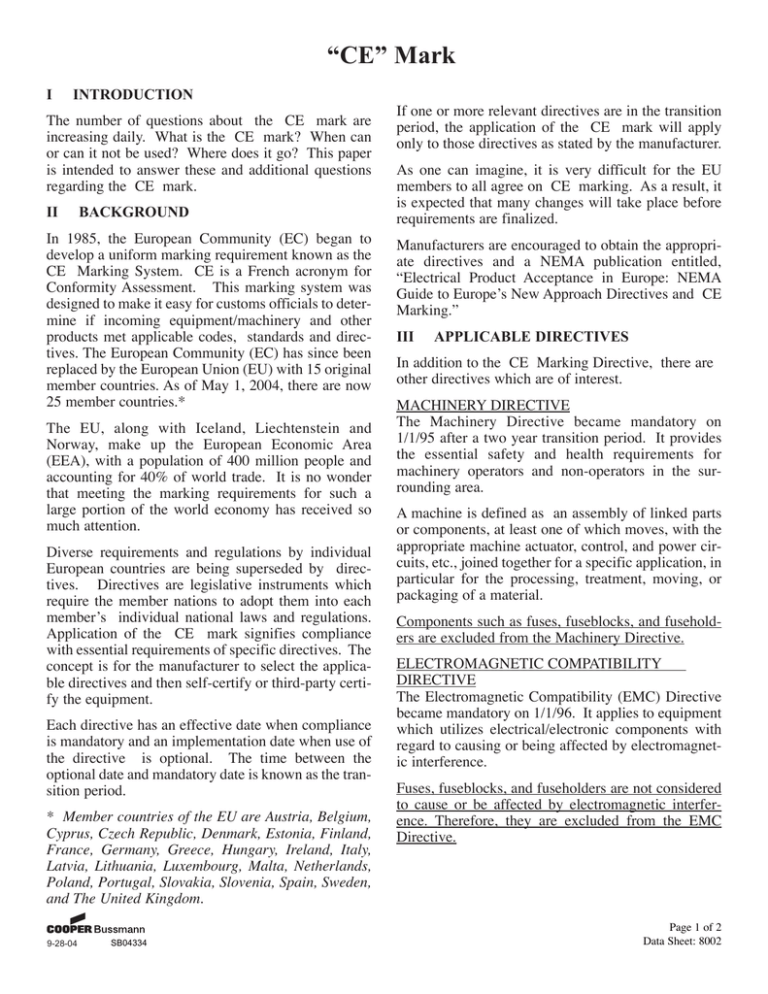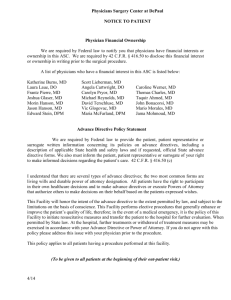I INTRODUCTION
advertisement

“CE” Mark I INTRODUCTION The number of questions about the CE mark are increasing daily. What is the CE mark? When can or can it not be used? Where does it go? This paper is intended to answer these and additional questions regarding the CE mark. II BACKGROUND In 1985, the European Community (EC) began to develop a uniform marking requirement known as the CE Marking System. CE is a French acronym for Conformity Assessment. This marking system was designed to make it easy for customs officials to determine if incoming equipment/machinery and other products met applicable codes, standards and directives. The European Community (EC) has since been replaced by the European Union (EU) with 15 original member countries. As of May 1, 2004, there are now 25 member countries.* The EU, along with Iceland, Liechtenstein and Norway, make up the European Economic Area (EEA), with a population of 400 million people and accounting for 40% of world trade. It is no wonder that meeting the marking requirements for such a large portion of the world economy has received so much attention. Diverse requirements and regulations by individual European countries are being superseded by directives. Directives are legislative instruments which require the member nations to adopt them into each memberÕs individual national laws and regulations. Application of the CE mark signifies compliance with essential requirements of specific directives. The concept is for the manufacturer to select the applicable directives and then self-certify or third-party certify the equipment. Each directive has an effective date when compliance is mandatory and an implementation date when use of the directive is optional. The time between the optional date and mandatory date is known as the transition period. * Member countries of the EU are Austria, Belgium, Cyprus, Czech Republic, Denmark, Estonia, Finland, France, Germany, Greece, Hungary, Ireland, Italy, Latvia, Lithuania, Luxembourg, Malta, Netherlands, Poland, Portugal, Slovakia, Slovenia, Spain, Sweden, and The United Kingdom. 9-28-04 SB04334 If one or more relevant directives are in the transition period, the application of the CE mark will apply only to those directives as stated by the manufacturer. As one can imagine, it is very difficult for the EU members to all agree on CE marking. As a result, it is expected that many changes will take place before requirements are finalized. Manufacturers are encouraged to obtain the appropriate directives and a NEMA publication entitled, ÒElectrical Product Acceptance in Europe: NEMA Guide to EuropeÕs New Approach Directives and CE Marking.Ó III APPLICABLE DIRECTIVES In addition to the CE Marking Directive, there are other directives which are of interest. MACHINERY DIRECTIVE The Machinery Directive became mandatory on 1/1/95 after a two year transition period. It provides the essential safety and health requirements for machinery operators and non-operators in the surrounding area. A machine is defined as an assembly of linked parts or components, at least one of which moves, with the appropriate machine actuator, control, and power circuits, etc., joined together for a specific application, in particular for the processing, treatment, moving, or packaging of a material. Components such as fuses, fuseblocks, and fuseholders are excluded from the Machinery Directive. ELECTROMAGNETIC COMPATIBILITY DIRECTIVE The Electromagnetic Compatibility (EMC) Directive became mandatory on 1/1/96. It applies to equipment which utilizes electrical/electronic components with regard to causing or being affected by electromagnetic interference. Fuses, fuseblocks, and fuseholders are not considered to cause or be affected by electromagnetic interference. Therefore, they are excluded from the EMC Directive. Page 1 of 2 Data Sheet: 8002 LOW VOLTAGE DIRECTIVE The Low Voltage (LV) Directive became mandatory on 1/1/97. This directive covers electrical equipment from 50 through 1000 volts AC and 75 through 1500 volts DC. Components intended only for use in the equipment of another manufacturer do not require the CE mark, but if the components are sold to an end user or installer, they must have the CE mark. Because fuses, fuseholders, and fuseblocks are often sold to an end user or installer, they apply to this (LV) directive. IV ¥ The CE mark is intended to provide products with a commercial Passport to designate conformance to the relevant EU Directives and allow the products to freely circulate within the EU. ¥ The CE mark is not a quality mark or a laboratory certification mark, i.e. UL, CSA, BSI, VDE, etc. ¥ Bussmann began placing the CE mark on applicable products, packaging, and/or documentation in the fourth quarter of 1996. MARKING Before affixing the CE mark, the manufacturer must fill out a legal document entitled the Declaration of Conformity. This document states, among other things, what applicable EU product standards or test methods are met. It must be kept on file with a representative of the manufacturer who resides in the EU. In addition, the manufacturer must develop a technical file on the equipment, or make reference to where the information can be found. After this has been completed, the CE mark can be applied to the equipment. The CE mark may be affixed by the manufacturer or the authorized representative. For the Low Voltage (LV) Directive, the CE mark may be affixed on the product, package, instructions, or guarantee. Bussmann began placing the CE mark on applicable products, packaging, and/or documentation in the fourth quarter of 1996. V SUMMARY ¥ According to the Low Voltage Directive, components which are sold to OEMs do not need the CE mark. They only need to be marked when they are sold to an end user or installer. ¥ The marking may be on the product, package, instructions or documentation. ¥ CE marking requirements are in a state of flux, and as such, may change considerably. ¥ Manufacturers are encouraged to purchase all applicable directives. 9-28-04 SB04334 Page 2 of 2 Data Sheet: 8002


